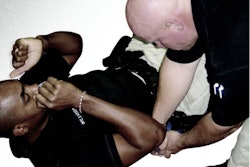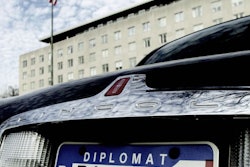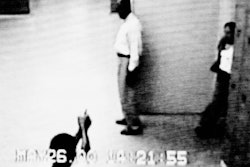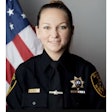It's one of the maxims of working patrol: No matter what day of the week, no matter what time of night, things can go to hell in a heartbeat. It didn't take long for Los Angeles County Sheriff's Deputy Michael Claus to learn how true this saying can be.
Claus spent the early years of his career working the Athens area of the county. Athens near the city of Carson is an unincorporated dollop of county property and, by county charter, it's patrolled by the Sheriff's Department. It's a place where young deputies season very quickly.
Back in 1987, Claus had been at the Carson Sheriff's Station for only a short time. But he was appointed as a training officer.
Claus' trainee was Dep. Brant Tunget. With only six weeks under his belt, Tunget was proving to be a quick study. Claus felt fortunate to have him as his first trainee. The two had made the most of their time together, getting to know what each could expect from the other if things went south. They'd had ample opportunity to discuss tactics and what each would do in a variety of emergency situations.
Looking back, both will tell you that their planning for the worst proved invaluable.
The Drive-By
Claus and Tunget were patrolling the Athens area at about 20:45 on Jan. 14, 1987, when they heard staccato bursts of rapid fire gunshots. It sounded like they were coming from the adjacent street. Claus put the radio car in gear, and he and Tunget drove toward the gunfire.
Claus cruised north across East 126th Street, visually scanning the area for any activity that might be associated with the shooting. Just then, an Oldsmobile turned off 126th Street and passed them. The deputies looked down 126th Street. Nothing.
The list of likely suspects had suddenly narrowed to the guy driving the Oldsmobile. Claus fell in behind the Olds, broadcasting over the Sheriff's radio that they were following a possible felony shooting suspect. Dispatch checked the license plate of the Olds and reported back to Claus that it was stolen.
The driver of the Olds, Wayne Bundage, piloted his car west on East 121st Street from Main Street, the black-and-white Sheriff's unit was right there with him. An unmistakable odor of gun powder wafted through the open windows of the patrol car, and Claus advised dispatch that he was now in pursuit.
Bundage, 19, was a Piru Blood, right down to the color-coordinated red Reebok baseball cap he was wearing. He had a series of robberies and assaults under his belt and, not surprisingly, he responded with Pavlovian conditioning at the sound of the deputies' siren. He ran.
Bundage performed a series of dangerous high-speed maneuvers and hair-pin turns designed to evade the pursuing deputies. Twice he misjudged his speed in the turns, slamming violently into opposing curbs before skidding into an alley. Once in the alley, Bundage began a cat-and-mouse game with the deputies, alternately slowing and accelerating the Olds.
Claus recognized the behavior. "This guy's gonna rabbit," he told Tunget.
Both Claus and Tunget unbuckled their seatbelts in preparation for a possible foot pursuit. But about halfway down the alley, Bundage suddenly accelerated. The Olds hit a dip and went airborne, crashing back to the asphalt, sparks spraying from its undercarriage.
The collective toll of curb and street impacts had ruptured the tires of the Olds, which skidded from the alley across Broadway and jumped a curb before flying into the north end of Athens Park.
Claus braked sharply before following the suspect's car into the park.
The patrol car's headlights lit up the Olds. Inside, Bundage raised an object wrapped in a green jacket with his right hand. The deputies watched him shake the object twice in a downward motion. On the second shake the jacket fell off, exposing a MAC-10 machine pistol.
Limping for an additional 100 yards, the Olds skirted a swimming pool before crashing into the support pole of a covered lunch shelter in the park picnic area. The Olds was done.
Bundage threw open the driver's side door and started to get out with the MAC-10 in his hand.
He's Got Us!
Throughout the pursuit, Claus believed that Bundage was going to dump the car and the gun and run. Now, he knew better.
"He's got us!" Claus yelled. "I'm going to ram him!"
Three car lengths separated the patrol car from the Olds. Claus gunned the engine and rammed the patrol car into the rear of the suspect's vehicle.
The impact propelled Bundage's upper body into the space between the front door frame and the open door. Bundage hesitated, trying to get his bearing.
Claus jumped behind the open front door of the patrol car and drew down on Bundage.
Bundage was crouched next to the driver's seat, fully exposed. Both deputies assumed combat positions.
Tunget was partially seated with his left foot on the floorboard and his right foot on the ground. He aimed his service revolver between the doorframe and the open passenger door, but he had difficulty getting a bearing on the suspect.
Claus stood behind his open door, knees slightly bent with his service revolver held in front of him in a two-handed grip. He lacked good cover and most of his upper torso was exposed, but he didn't have time to move.
Bundage leveled the Mac-10 and fired. Nine-millimeter slugs peppered the air, but Claus held his aim.
Claus squeezed off six rapid-fire shots from his Smith & Wesson 686 revolver. Bundage was hit. He fell back into a sitting position in the driver's seat of the Olds. But he wasn't out. He continued shooting over his left shoulder at Claus.
His service revolver expended, Claus crouched beside the driver's seat. He reached into the radio car to key the radio car's microphone and advise responding units that he and Tunget had been involved in a shooting and needed assistance.
Tossing the microphone aside, Claus sprinted to the rear of the radio car to reload. But as he bent near the rear bumper, Claus experienced catastrophic equipment failure: His speed loader had jammed against the revolver cylinder.
Seeing Claus leaning back into the radio car, Tunget thought his partner had been shot. Tunget left his position of cover and ran to the right side of the Olds.
Tunget held his revolver in a combat stance near the rear passenger window of the Olds. He fired five times and the Olds' window disintegrated.
Bundage returned fire. Four rounds buzzed past Tunget's right ear, and a shard of glass peppered his face.
His own rounds expended, Tunget dumped the spent cartridges as he sprinted to the back of the radio car where he rejoined Claus. Relieved that his training officer was not injured, Tunget reached into his back pants pocket for the two-inch Chief he carried as a backup. He tossed the Chief to Claus and reloaded.
Claus caught a glimpse of Bundage as he darted from the open driver's door toward the front of the Olds. Both deputies then heard a noise that sounded like a slide action of an automatic weapon. Claus shouted at the suspect to give up and come out.
Perhaps his gun was jammed. Maybe the eight bullets his body had absorbed had something to do with it. Whatever the reason, Bundage's cost-benefit analysis convinced him to toss the MAC-10. It landed about 10 feet to the front left of the Oldsmobile.
Claus yelled for Bundage to step away from the car, keeping his hands in plain view. Bundage complied, lying on the grass in a felony prone position.
Catalyst for Change
The entire shooting had lasted about 10 seconds.
Amazingly, despite exchanging rounds at distances ranging from four to 15 feet with a more heavily armed suspect, neither deputy was hurt.
Bundage was transported to Martin Luther King Hospital, where he was treated prior to being booked for a variety of charges, including attempted murder of a peace officer. He was eventually sentenced to 10 years in prison.
In the weeks following the shooting, the L.A. Sheriff's Department conducted an in-depth critique of the shooting and the tactics employed by the deputies. The conclusions resulted in a study on the effectiveness of ramming suspect vehicles. They also revealed a need for more realistic "combat shoot" training for deputies. And they were a major catalyst for the Sheriff's Department changing from revolvers to Berettas.
Lessons Learned
Dep. Tunget has retired from the Sheriff's Department. Dep. Claus is now Lt. Claus.
Claus believes the shooting was a valuable learning experience. And he is reflective enough to recognize where things went well and where things might have been done differently.
Some of Claus' and Tunget's actions were undeniably effective. Claus' aggressive rapid fire attack on the suspect not only injured the suspect, but forced him to retreat into the Olds where his aim was compromised. The fact that Tunget carried a backup weapon also proved important.
Claus is just as forthcoming with what he feels he could have done better before and during the shooting. He wonders if he should have maintained a greater distance from the vehicle at the conclusion of the pursuit? The textbook part of his mind says, "yes." But the practical part of him recognizes that it was that close proximity to the suspect's vehicle that availed him the opportunity to jar the suspect and buy an extra precious second or two in what could have been a disastrous firefight.
That's perhaps the most important lesson for law enforcement officers to learn from this incident. An extra second or two may be all the difference in the world.














